 |
 |
 |
| |
Vitamin D3 Supplementation Decreases Parathyroid Hormone (PTH) in HIV-Infected Youth Being Treated with Tenofovir-Containing Combination Antiretroviral Therapy: Randomized, Double-blind, Placebo-controlled Multicenter Trial Adolescent Trials Network (ATN) study 063
|
| |
| |
Reported by Jules Levin
CROI 2011 Boston March 29, 2011
Peter Havens (presenter), Rohan Hazra, Charles Stephensen, Marta van Loan, Brandy Rutledge, James Bethel, Cynthia Pan, Nancy Liu, Jorge Lujan-Zilbermann, Kathleen Mulligan, for the ATN study 063 team
CROI: Bone and Vitamin D at CROI 2011 - By Todd T. Brown, MD, PhD - (03/26/11)
In Brown's report he comments on TDF, PTH, vit D supplementation & this study.
In the Q&A following his talk Havens was asked by Jose Arribas, the session co-chair, how many people were taking EFV & if that affected vitamin D and in response Havens said at baseline EFV did affect vit D but did not affect a control in change in vit D. The next study Havens said will include calcium supplementation.
In this study vitamin D3 supplements decreased parathyroid hormone in youth treated with tenofovir regardless of baseline vitamin D status. This vitamin D effect was not seen in youth not treated with tenofovir. There were no changes in renal phosphate handling or markers of bone turnover. There were no clinical or biochemical toxicities associated with this treatment.
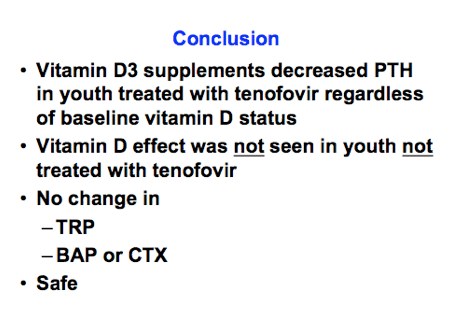
The large sample size, prospective randomized design, and use of directly observed therapy strengthen our confidence in the study findings.
The study was only 12 weeks in duration. A longer study might identify a bigger decline in PTH. Calcium intake, an important factor in parathyroid hormone concentration, was not controlled. We did not measure change in bone mineral density, or rate of bone fractures, so the clinical importance of these findings remains unknown.
Thank you very much. This is the end of my prepared remarks and now, I think, there is time for questions.
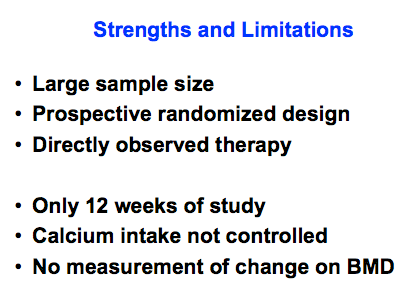
I gratefully acknowledge the contributions of Kathy Mulligan, colleagues from the ATN and other institutions, participants at 15 ATN and 19 IMPAACT sites, and funding from the NIH.
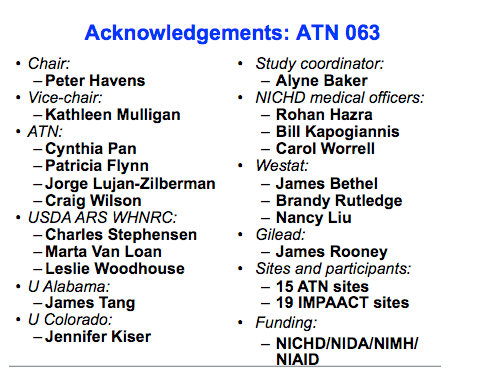
Serum 25-hydroxy vitamin D is the best indicator of vitamin D nutritional status, which is categorized as deficient, insufficient, sufficient, and excess. In this study, we lump deficient with insufficient, and sufficient with excess, at a cut-point of 20 nanograms per ml.
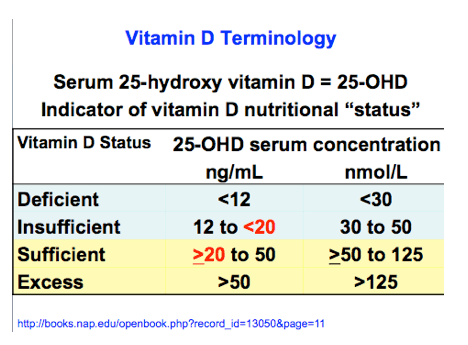
In the kidney, tenofovir use is associated with decreased glomerular filtration, increased urinary beta 2 microglobulin, and decreased renal tubular reabsorption of phosphate. Tenofovir also affects calcium homeostasis and bone metabolism, with increased parathyroid hormone, increased markers of bone turnover, and decreased bone mineral density.
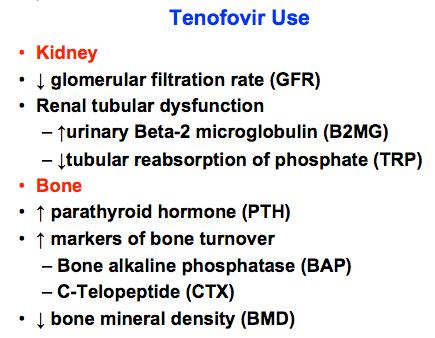
Vitamin D deficiency has renal effects that include phosphate wasting, and bone effects including increased PTH and decreased bone mineral density.
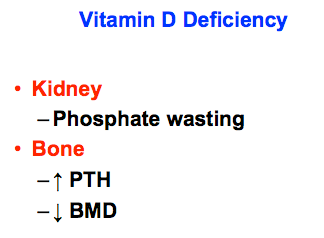
So tenofovir use looks similar to vitamin D deficiency, with decreased TRP and increased PTH. In patients with vitamin D deficiency, vitamin D treatment increases tubular reabsorption of phosphate and decreases PTH, with resultant increase in bone mineral density.
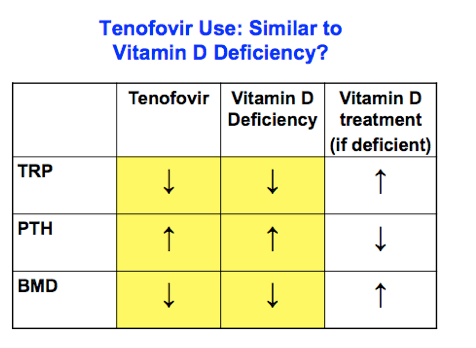
We hypothesized that vitamin D supplementation in youth being treated with tenofovir will Increase tubular reabsorption of phosphate; decrease Bone Alkaline Phosphatase and C-telopeptide; and decrease parathyroid hormone.
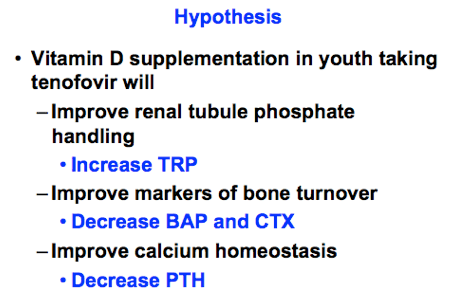
We studied youth with HIV infection, ages 18-25 years, on stable combination antiretroviral therapy, with low viral load. Screening excluded those with hypercalcemia or hypercalcuria.
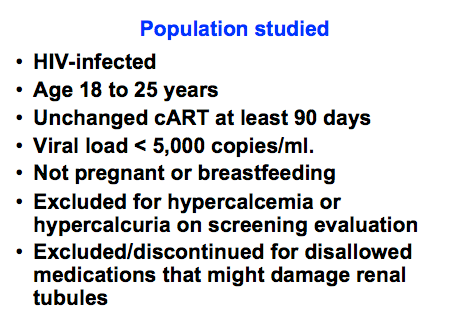
There was no exclusion based on vitamin D concentration. Subjects were initially chosen based on the presence or absence of tenofovir in their combination antiretroviral regimen, and then randomized within tenofovir or no-tenofovir groups to either receive vitamin D or placebo.

Randomized treatment was with vitamin D3 - 50,000 units, or matching placebo, given in three directly observed oral doses at baseline, week 4, and week 8. Monthly dosing was chosen to enhance compliance.
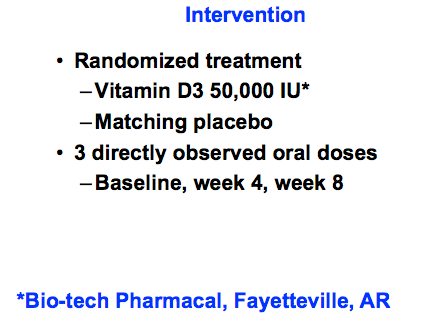
Measurements were made at baseline and week 12 for the main outcome variables, and to identify changes in glomerular and renal tubular function. We monitored safety every 4 weeks.
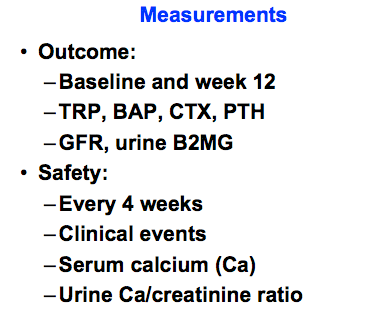
At baseline there were 118 participants taking tenofovir, and 85 who did not have tenofovir included in their current antiretroviral regimen. An overall 17% drop-out rate was similar in all study arms, and was mostly from use of disallowed medications or loss to follow-up.
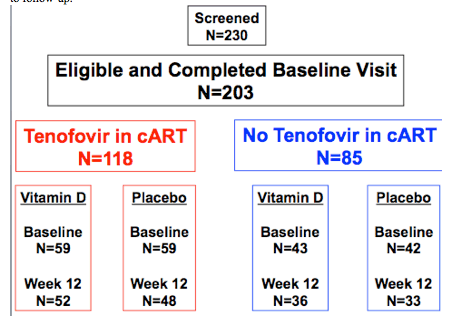
Mean age of study participants was 21 years. The sample was 37% female and 52% African American. Mean CD4 cell count was 587. 55% were vitamin D deficient or insufficient at baseline. There were no baseline differences in those randomized to vitamin D or placebo.
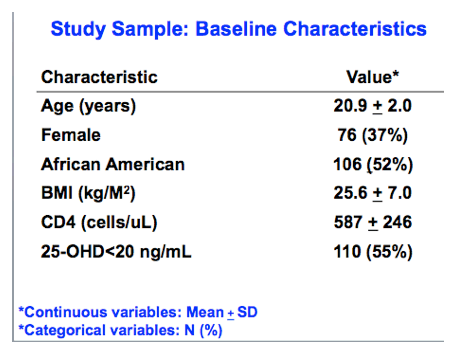
Baseline differences were found in participants treated with tenofovir or not treated with tenofovir. GFR was lower and urine beta 2 microglobulin was higher in the tenofovir group. Tenofovir was associated with lower TRP and higher PTH and C-Telopeptide. However, when adjusted for baseline characteristics in multivariable models, the tenofovir association with GFR and urine beta-2 microglobulin was less strong. In multivariable models, the only baseline differences that remained significant were TRP and parathyroid hormone.
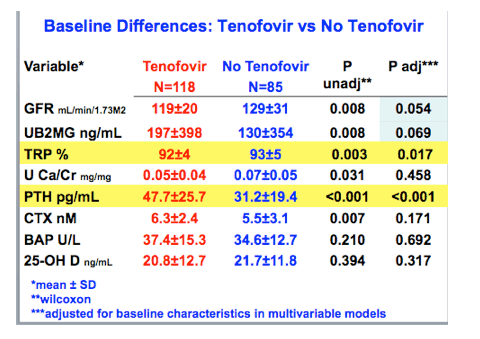
Parathyroid hormone at baseline was higher in subjects with insufficient compared with sufficient vitamin D status, which is physiologically appropriate. Baseline PTH was also higher in patients taking tenofovir compared with those not taking tenofovir.
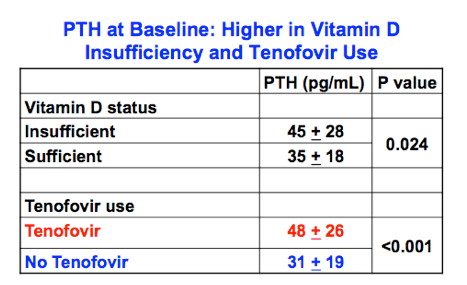
This slide shows baseline PTH on the Y axis, and vitamin D status on the X axis. PTH was higher in participants using tenofovir (shown in red) compared with those not using tenofovir (shown in blue). This association of tenofovir with increased PTH was seen in those with vitamin D insufficiency (shown in the left pair of bars) and in those with sufficient vitamin D status at baseline (shown in the right pair of bars).
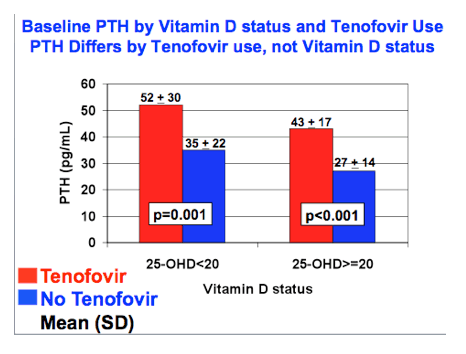
Vitamin D treatment increased serum vitamin D concentration from 21 at baseline to 35 at week 12. 95% of participants treated with vitamin D had sufficient vitamin D by week 12.
There was no change in serum vitamin D concentration in the placebo group.
Tenofovir did not have any effect on the change in vitamin D serum concentration.
There were no clinical or biochemical toxicities associated with this treatment.
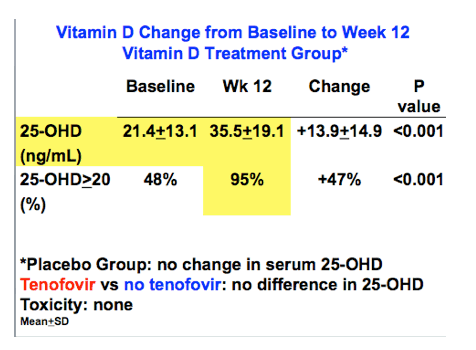
We measured the change from baseline to week 12, in the main outcome variables, by treatment with vitamin D or placebo. Placebo had no effect. The vitamin D treatment effect was dramatically different in participants in the tenofovir compared with the no-tenofovir group.
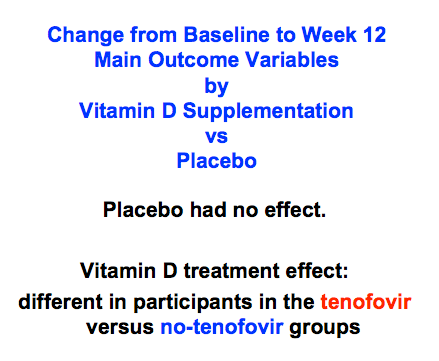
In those not treated with tenofovir, there were no changes in any of the main outcome variables including tubular reabsorption of phosphate, bone alkaline phosphatase, C-Telopeptide, or parathyroid hormone, in either the vitamin D or placebo groups.

However, in those taking tenofovir, vitamin D supplementation led to a decrease in parathyroid hormone from baseline to week 12. There were no other changes in the main outcome variables. Small changes in markers of bone turnover were not consistently significant in multivariable analyses. There were no changes in any of these variables in the placebo group.
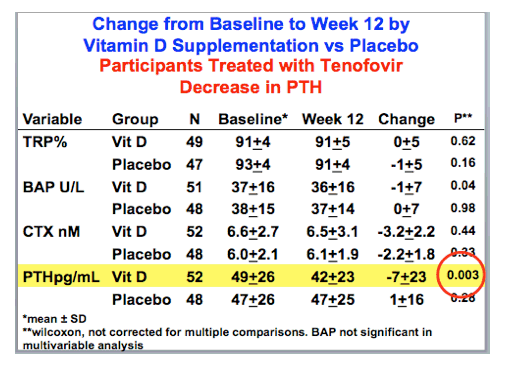
This slide shows parathyroid hormone concentration on the Y axis, and vitamin D status on the X axis. The green bars are PTH values at baseline, and the orange bars are values at week 12. This slide only shows participants whose antiretrovirals included tenofovir, and who were randomized to vitamin D treatment.
Overall, from baseline to week 12, SLIDE, there was a PTH decrease of 7 picograms per ml in the vitamin D treatment group. In participants who were vitamin D insufficient at baseline, SLIDE, the PTH decrease was 8 picograms per milliliter. Even in those participants with sufficient vitamin D status at baseline SLIDE there was a PTH decrease of 6 picograms per mL in response to vitamin D treatment.

|
| |
|
 |
 |
|
|